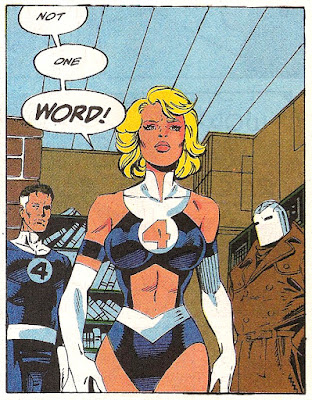Story/Script by Jim Lee and Brandon Choi, Penciled by Scott Clark, Inked by Trevor Scott
I think I’m pretty open-minded when it comes to 90’s comics. I’ve really tried to emphasize that the 90’s were not all gigantic guns and weirdly proportioned women gritting their teeth at one another. That said, that’s exactly what Stormwatch #1 is. It’s everything you associate with an early 90’s X-Men comic except it replaces the characters you know and like with poorly designed doppelgangers!
We begin with Battalion, the aging, gun-toting, African-American leader of the Stormwatch as he leads his strike team of Fiji the even-keeled Japanese muscleman, Diva, the hot chick, Hellstrike, and Winter (I don’t know anything about these guys, they each get about one line). They are on assignment in Sarajevo to rescue an old friend of Battalion who is trying to get a school bus full of genetically important children to safety. The bus is attacked by the “Mercs,” an evil Brotherhood-like team led by Deathstroke the Terminator, I mean… Deathtrap. Let me guess, he's named “Blade” Wilson? Deathtrap is joined by Slayer, Razer, and Kilgore, with Kilgore as the Wolverine/Sabretooth type. Slayer and Diva square off, and we learn that Slayer was a good guy and that she talks like Rogue. I am not exaggerating. “I’ve become an exceptional cold-blooded killa, sugah.” Mid-fight, another Merc appears, a spikey-shoulderpad wearing guy that looks like minor villain “Ahab.” The mission goes well-enough, except Battalion’s friend gets murdered by Deathtrap.
Battalion wakes up in New York, re-living the events of the battle, when his mom comes in to tell him someone’s at the door. Synergy, a Stormwatch employee and former rival, is there with some government goons. Battalion’s brother Malcolm was arrested for robbery, but his diplomatic immunity gets him off the hook. Battalion listens to his brother’s insane story of his arrest, featuring pony-tailed white men breaking into an electronics shop for zero reason and carrying off televisions. Malcolm doesn’t actually take anything, but he runs off with his pals. When the police arrive, his pony-tailed idiot friend produces a gun and tries to shoot the cops, but gets shot to death for his trouble. The officer, having shot the kid to death, has his gun drawn on the unarmed teen and shouts “Don’t make me do it, son!” Which I mean, good for him for not shooting an unarmed teen for standing too close to an armed white guy! I feel like that would have been a bad thing to do! Battalion calls his brother Malcolm “boy” and lectures him for being a disappointment.
The next day, Battalion and his family are at his friend’s funeral, when who should appear but the Mercs. They start blasting everywhere, and Malcolm gets shot. Synergy checks on him and finds he’s completely unhurt. But that means… Battalion is forced to let Synergy “activate” his brother’s potential powers, causing pink optic blasts to shoot out of Malcolm. To be continued!
Review:
Let me start by saying some nice things. Scott Clark (RIP) has some nice pencils. He’s not a superstar artist, and I think he may be tracing Jim Lee or some other contemporary artists on some of this, but overall his linework is clear and solid. Malibu’s vaunted coloring process is on display as the coloring is pretty good.
On the other hand, the first fight scene is staged incomprehensibly. I don’t know how much design work he put into these characters, but they all feel like below-average Lee/Liefeld action figures, and I say that as someone who had action figures of Gideon and other Externals. The plot is pretty much a train-wreck from jump-street, built around two confrontations with the blankest slate bad guys, mercenaries creatively called the Mercs. This is also a first issue that doesn’t introduce much in the way of character, setting, or anything else, devoted as it is to confusing fight scenes where new, unnamed characters appear halfway through. As alluded to, the rest of the team doesn’t ever talk to Battalion, who isn’t particularly sympathetic as he lectures his brother for having loser friends. The whole Malcolm scene is completely ridiculous, with Malcolm inexplicably getting caught up in the worst-planned theft in history. Typical NYPD cops though, talking about how they were going to charge him with “robbery,” even though it was clearly theft. Why is Malcolm associating with these clowns? Why are the heroes so flat-footed when the Mercs show up at the funeral? How did the mission even end, since we cut out that part? Why does Deadshot re-use essentially the same line about how he should have killed Battalion in Kuwait both times he sees the guy?
90’s Fashion: so much! Battalion’s costume is full of pouches, electronic doo-dads, and huge shoulder pads. Diva wears a Psylocke-style one-piece with knee-high boots, complete with spikes going around her thigh, and a pouch-belt around her waist. Winter wears a jacket over his bodysuit. Deathtrap has even more pouches, and an over-one-shoulder bandolier. Slayer, another member of the Mercs, is just wearing one of Magneto’s acolyte costumes she found lying around. Synergy wears a short red dress with a big blue jacket over it to Battalion’s home. Stoney, one of Malcolm’s pals, has a long, stringy ponytail. One of the Bosnian(?) schoolchildren is wearing an Image t-shirt.







